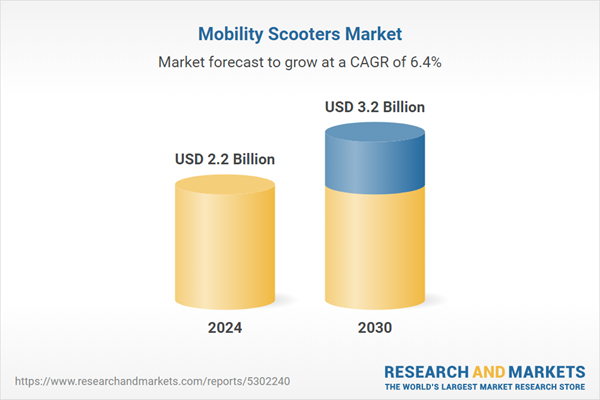Global Mobility Scooters Market - Key Trends and Drivers Summarized
How Have Mobility Scooters Revolutionized Personal Transportation?
Mobility scooters have transformed the personal mobility landscape, providing a practical and empowering solution for individuals with limited physical ability or those experiencing difficulties with prolonged walking. Originally designed as a medical device for people with disabilities, mobility scooters have evolved into a versatile form of transportation that bridges the gap between traditional wheelchairs and motorized vehicles. These scooters offer greater independence and autonomy, allowing users to navigate urban and suburban spaces with ease, whether it’s running errands, attending social gatherings, or enjoying recreational outings. Available in a variety of models ranging from compact, foldable scooters to heavy-duty, all-terrain variants, mobility scooters cater to diverse needs and preferences. This versatility makes them suitable for indoor use, narrow passageways, or even rugged outdoor environments. With features like adjustable seating, armrests, and user-friendly controls, modern mobility scooters provide both comfort and convenience, enhancing the overall quality of life for users. As a result, they have gained widespread acceptance not only among the elderly and disabled community but also among individuals seeking enhanced mobility due to conditions like arthritis, obesity, or temporary injuries.Why Are Mobility Scooters Gaining Popularity Among a Wider Audience?
The growing popularity of mobility scooters can be attributed to changing demographics, increasing awareness of assistive technologies, and a societal shift towards more inclusive urban mobility solutions. One of the primary drivers is the aging global population; as people live longer, the prevalence of mobility-related challenges has increased, prompting a surge in demand for solutions that support active aging. According to the World Health Organization, by 2050, the population aged 60 years and older is expected to reach 2 billion, up from 900 million in 2015. This demographic shift has placed a spotlight on mobility aids, positioning scooters as a vital means for seniors to maintain their independence and reduce their reliance on caregivers. However, it’s not just the elderly who are benefiting from this technology. The younger demographic, particularly those dealing with chronic conditions or post-surgical recovery, are turning to mobility scooters as a temporary yet practical solution for maintaining their active lifestyles. Additionally, heightened awareness of mobility options, driven by increased advertising, better accessibility in public spaces, and the growing presence of mobility scooters in online and retail stores, has made these devices more visible and less stigmatized. This normalization has widened the customer base, making mobility scooters appealing to a diverse range of users beyond traditional target groups. Moreover, advancements in design aesthetics and technology have enhanced their visual appeal, resulting in sleeker, more compact models.How Are Technological Advancements and Product Innovations Shaping the Market?
Technological advancements and product innovations are playing a pivotal role in redefining the capabilities and appeal of mobility scooters. Today’s scooters are equipped with cutting-edge features that improve safety, usability, and performance, making them suitable for a broader range of applications. Lithium-ion battery technology, for instance, has dramatically extended the range and battery life of mobility scooters, allowing users to travel greater distances on a single charge while reducing overall weight. This development has been particularly significant for portable models that can be disassembled or folded for easy transport and storage, making them ideal for travelers and urban dwellers. Another major innovation is the integration of smart technology. Many high-end mobility scooters now come with digital displays, GPS tracking, and smartphone connectivity, enabling users to monitor battery levels, track routes, and even lock their scooters remotely. Enhanced safety features, such as anti-tip mechanisms, electronic stability control, and improved braking systems, have also become standard, addressing concerns about the safety of using these devices in busy environments. Comfort has not been overlooked either - ergonomic designs with suspension systems, cushioned seats, and shock absorbers provide a smoother ride, even on uneven terrains. Moreover, manufacturers are focusing on aesthetics, offering customizable options with varied colors, accessories, and contemporary designs that appeal to a younger audience.What Factors Are Fueling Expansion of the Mobility Scooter Market?
The growth in the mobility scooter market is driven by several factors. One of the key growth drivers is the increasing global geriatric population, particularly in developed countries such as the United States, Japan, and across Europe, where aging demographics are prompting a surge in demand for assistive devices that support active aging. As more people experience age-related mobility challenges, the need for reliable and easy-to-use transportation options has become paramount. Additionally, there is a rising prevalence of chronic conditions such as arthritis, diabetes, and obesity, which contribute to long-term mobility impairments, creating a larger pool of potential users beyond just the elderly. Another major factor propelling market growth is the rapid urbanization and development of more inclusive infrastructure, such as accessible public transport and barrier-free city layouts. Consumer expectations are also evolving, with a growing demand for technologically advanced models that offer enhanced safety, comfort, and connectivity. Manufacturers are responding by introducing models equipped with smart features like GPS navigation, remote control capabilities, and advanced suspension systems, which cater to both safety and convenience. The expansion of distribution channels, including e-commerce platforms and specialty medical equipment stores, has also played a crucial role, making mobility scooters more accessible to a global audience. Lastly, government initiatives and subsidies aimed at improving the mobility and independence of individuals with disabilities are providing financial support and incentives for purchasing mobility scooters, contributing to the market’s positive outlook. Collectively, these factors indicate a robust and sustainable growth trajectory for the mobility scooter market, reflecting a convergence of technological progress, demographic shifts, and evolving consumer preferences.Report Scope
The report analyzes the Mobility Scooters market, presented in terms of units. The analysis covers the key segments and geographic regions outlined below.Segments: Wheel Type (4 Wheel, 3 Wheel, Other Wheel Types); End-Use (Personal, Institutional).
Geographic Regions/Countries: World; United States; Canada; Japan; China; Europe (France; Germany; Italy; United Kingdom; and Rest of Europe); Asia-Pacific; Rest of World.
Key Insights:
- Market Growth: Understand the significant growth trajectory of the 4 Wheel segment, which is expected to reach US$2.1 Billion by 2030 with a CAGR of a 6.3%. The 3 Wheel segment is also set to grow at 6.9% CAGR over the analysis period.
- Regional Analysis: Gain insights into the U.S. market, valued at $598.2 Million in 2024, and China, forecasted to grow at an impressive 6.0% CAGR to reach $492.5 Million by 2030. Discover growth trends in other key regions, including Japan, Canada, Germany, and the Asia-Pacific.
Why You Should Buy This Report:
- Detailed Market Analysis: Access a thorough analysis of the Global Mobility Scooters Market, covering all major geographic regions and market segments.
- Competitive Insights: Get an overview of the competitive landscape, including the market presence of major players across different geographies.
- Future Trends and Drivers: Understand the key trends and drivers shaping the future of the Global Mobility Scooters Market.
- Actionable Insights: Benefit from actionable insights that can help you identify new revenue opportunities and make strategic business decisions.
Key Questions Answered:
- How is the Global Mobility Scooters Market expected to evolve by 2030?
- What are the main drivers and restraints affecting the market?
- Which market segments will grow the most over the forecast period?
- How will market shares for different regions and segments change by 2030?
- Who are the leading players in the market, and what are their prospects?
Report Features:
- Comprehensive Market Data: Independent analysis of annual sales and market forecasts in US$ Million from 2024 to 2030.
- In-Depth Regional Analysis: Detailed insights into key markets, including the U.S., China, Japan, Canada, Europe, Asia-Pacific, Latin America, Middle East, and Africa.
- Company Profiles: Coverage of players such as Afikim Electric Vehicles, Amigo Mobility International Inc., Drive Medical Design and Manufacturing, Electric Mobility, Golden Technologies Inc. and more.
- Complimentary Updates: Receive free report updates for one year to keep you informed of the latest market developments.
Some of the 16 companies featured in this Mobility Scooters market report include:
- Afikim Electric Vehicles
- Amigo Mobility International Inc.
- Drive Medical Design and Manufacturing
- Electric Mobility
- Golden Technologies Inc.
- Hoveround Corp.
- Invacare
- Pride Mobility Products
- Quingo
- Sunrise Medical
- Van Os Medical
Tariff Impact Analysis: Key Insights for 2025
Global tariff negotiations across 180+ countries are reshaping supply chains, costs, and competitiveness. This report reflects the latest developments as of April 2025 and incorporates forward-looking insights into the market outlook.The analysts continuously track trade developments worldwide, drawing insights from leading global economists and over 200 industry and policy institutions, including think tanks, trade organizations, and national economic advisory bodies. This intelligence is integrated into forecasting models to provide timely, data-driven analysis of emerging risks and opportunities.
What’s Included in This Edition:
- Tariff-adjusted market forecasts by region and segment
- Analysis of cost and supply chain implications by sourcing and trade exposure
- Strategic insights into geographic shifts
Buyers receive a free July 2025 update with:
- Finalized tariff impacts and new trade agreement effects
- Updated projections reflecting global sourcing and cost shifts
- Expanded country-specific coverage across the industry
Table of Contents
Companies Mentioned (Partial List)
A selection of companies mentioned in this report includes, but is not limited to:
- Afikim Electric Vehicles
- Amigo Mobility International Inc.
- Drive Medical Design and Manufacturing
- Electric Mobility
- Golden Technologies Inc.
- Hoveround Corp.
- Invacare
- Pride Mobility Products
- Quingo
- Sunrise Medical
- Van Os Medical
Table Information
| Report Attribute | Details |
|---|---|
| No. of Pages | 82 |
| Published | April 2025 |
| Forecast Period | 2024 - 2030 |
| Estimated Market Value ( USD | $ 2.2 Billion |
| Forecasted Market Value ( USD | $ 3.2 Billion |
| Compound Annual Growth Rate | 6.4% |
| Regions Covered | Global |









